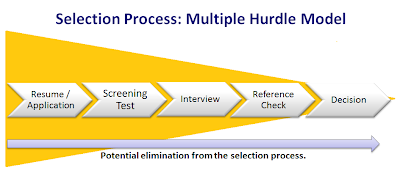This is the eighth in a 11 part series that looks at:
In the last blog we reviewed competency-based or behavioral interviews and noted in particular that behaviourally-based interview questions are based on the premise that past performance is the best predictor of future performance. The next two talent acquisition tools described in this blog are based on the same premise.- The Business Case
- Key Advantages of Competency-based Selection
- How Competencies Improve Selection
- Top 3 Features of Best Practice Recruitment and Selection - #1
- Top 3 Features of Best Practice Recruitment and Selection - #2
- Top 3 Features of Best Practice Recruitment and Selection - #3
- Common Tools: Job Postings & Behavioral Interviews
- Common Tools: Track Record Review and Reference Checks
- Common Tools: Standardized Tests, Part 1
- Common Tools: Standardized Tests, Part 2
- Tips for Implementing a Recruitment and Selection System
Competency-based Track Record / Portfolio Reviews
Track record / portfolio reviews allow employees / applicants to document their past experiences and accomplishments that relate to the competency requirements for positions within the organization. Once completed, trained evaluators score the extent to which the required competencies are demonstrated in the written examples using standardized scoring criteria. Typically, the candidate also provides references who can attest to the validity of the examples provided. Results can be used as part of the selection process and / or for other purposes (e.g., competency gap analysis for Learning and Development; Succession Management; HR Planning).
Competency-based Reference Check
A well-conducted reference check is a valuable source of information about a candidate’s past experiences and accomplishments. The reference check process gives the organization the opportunity to further explore specific competency areas and to verify information provided by the candidate during the selection interview. Like the selection interview, well-designed reference checking questions can be developed based on the competency dictionary of the organization and can be incorporated into Reference Checking guides that can be standardized for the various types of jobs in the organization.
The next blog in this series examines more commonly tools used in recruitment and selection. Sign up to our blog’s mailing list through the form on the right-hand side to receive the rest of the series in your inbox.
HRSG is a leader in competency-based recruitment and selection solutions and training. Contact us today to find out how we can help you.
 Want to learn more? Download a Best Practice Guide to Improve the Effectiveness of your Interviewing Processes
Want to learn more? Download a Best Practice Guide to Improve the Effectiveness of your Interviewing Processes Compared to unstructured interview approaches, the behavioral interview approach greatly increases your chances of making the best selection decisions. Download this guide to learn how to interview candidates to gather critical information about candidates’ past performance and accomplishments that you can use to predict their performance and accomplishments in the job that you are filling.







